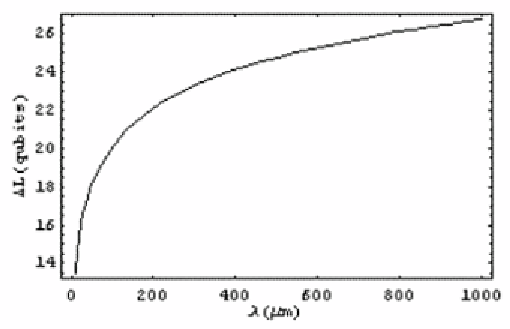Information Technology Reference
In-Depth Information
From Eqs.(18) and (22), it can be seen that the biological brain has the possibility to
perform high efficient computation up to 20 qubits more than conventional silicon processors)
with the same energy dissipation when satisfying
Δ
L
<
L
as shown in Figure 9 for the
λ 100=
, where photons would
propagate losslessly in a microtubule in the infra-red spectrum region [Hameroff, 2004], if we
let
μ
infrared light frequency, the wavelength of which is
d
15≈
, which is the same order as the extracellular space between the brain cells.
This result suggests that the human brain can perform computation efficiently in the
environment at high temperature compared with the conventional processors.
nm
Figure 9. Increase of quantum bits for quantum computation at the infrared spectrum region.
Tegmark [2000] calculated that microtubles in the warm and wet brain would cause
decoherence on the order of
10
−
13
10
τ
10
sec, which is slower by a factor at least
than the
3
4
τ
10
−
~
10
−
time scale of neuron firing,
sec, from
D
2
mk
T
B
τ
≈
(23)
2
Ngq
e
where
D
is the tublin diameter,
m
is the mass of an ion,
k
is a Boltzmann constant,
q
is an ionic charge and
N
/= .
Contrary to his calculation, it can be shown that quantum processor utilizing
superluminal evanescent photons can perform computation to satisfy the time scale required
for quantum computation in microtubles given as follows;
The decoherence time of the quantum system [Diosi, 2005] can be given by
Q
q
,
g
=
/1 πε
4
0
2
h
1
E
τ
=
τ
D
2
(
Δ
)
(24)
0
where
τ
is a certain time-scale to measure the strength of time uncertainties.





